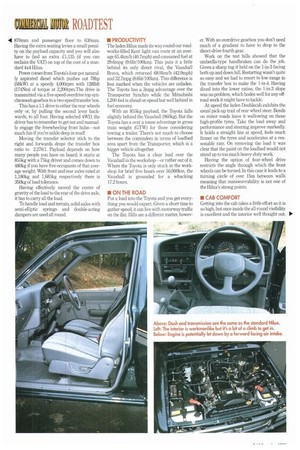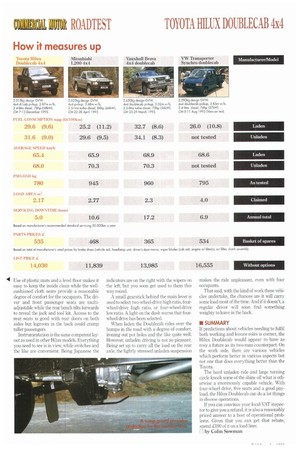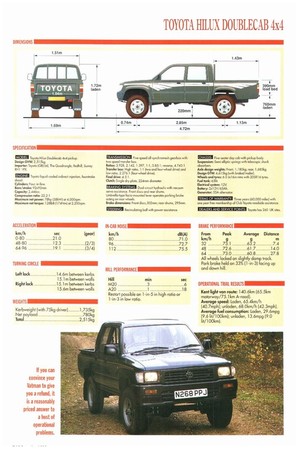OEM ROADTEST
Page 34

Page 36

Page 38

Page 37

If you've noticed an error in this article please click here to report it so we can fix it.
TOUGH
TWIN SET
The Doublecab variant of the Toyota Hilux takes five people at the expense of a bit of space and some payload. There are vehicles that do some jobs better, but few can match the Doublecab's all-round competence.
Many commercial vehicles can be launched without the public at large even noticing—but not the Toyota Hilux Doublecab 4x4. It's one of those vehicles that gets heads turning on the motorway and in the high-street. At the municipal tip we were even quizzed by prospective buyers: "How long have they been bringing these in? What's it like? flow much is it? Does it go well?"
When Toyota introduced the Hilux Doublecab at the London Motor Show it added a new dimension to an already popular vehicle. Toyota claims the Hilux is the world's best selling four-wheel-drive pickup with almost 40,000 sold in the first eight months of 1995. Now it has extended the Hilux's potential by extending the cab so that five people at a time can sample the delights.
You lose out on some loadspace and payload, but you gain the people moving capacity that some jobs require.
Vauxhall has already trodden this path with its Brava double cab and VW offers the Transporter Synchro. If you have the readies you might go for a special order like a County conversion on a crew-cab Transit or Land Rover Defender 130 crew-cab, but that's about it. Not just because it is a specialised market but also the glass in the back means these are classified as passenger vehicles by the VAT people.
Thus, having handed over £16,486— which includes 17.5% VAT—you will have to go into negotiations with the VATman to try and claim the £2,455 worth of VAT back again.
Toyota says you can claim the VAT back but only if your Doublecab is: a designated work vehicle; not assigned to any one person; and is always returned to the works' yard over night.
• PRODUCT PROFILE Toyota has used the standard Hilux 4x4 chassis, stretched the cab by 750mm and, by way of compensation, it has shortened the loadbed by 755mm to 1,435min. The vehicle is also 40mm higher than the standard Hilux 4x4. This takes the unladen loadbed height to l■ • 870nun and passenger floor to 630mm_ Having the extra seating levies a small penalty on the payload capacity and you will also have to find an extra £1,135 (if you can reclaim the VAT) on top of the cost of a standard 4x4 Hilux.
Power comes from Toyota's four-pot naturally aspirated diesel which pushes out 78hp (58kW) at a speedy 4,000rpm with 1281bft (174Nm) of torque at 2,200rpm.The drive is transmitted via a five-speed overdrive top synchromesh gearbox to a two-speed transfer box.
This has a 1:1 drive to either the rear wheels only or, by pulling the second lever backwards, to all four. Having selected 4WD, the driver has to remember to get out and manually engage the freewheeling front hubs—not much fun if you're ankle-deep in mud!
Moving the transfer selector stick to the right and forwards drops the transfer box ratio to 2.276:1. Payload depends on how many people you have on board: it starts at 855kg with a 75kg driver and comes down to 480kg if you have five occupants of that average weight. With front and rear axles rated at 1,180kg and 1,685kg respectively there is 350kg of load tolerance.
Having effectively moved the centre of gravity of the load to the rear of the drive axle, it has to carry all the load.
To handle load and terrain, solid axles with semi-elliptic springs and double-acting dampers are used all round. • PRODUCTIVITY The laden Hilux made its way round our roadworks-filled Kent light van route at an average 65.4km/h (40.7mph) and consumed fuel at 29.6mpg (9.61it/100km). This puts it a little behind its only direct rival, the Vauxhall Brava, which returned 68.9km/h (42.9mph) and 32.7mpg (8.61it/100km). This difference is less marked when the vehicles are unladen. The Toyota has a 3mpg advantage over the Transporter Synchro while the Mitsubishi 1200 4x4 is ahead on speed but well behind in fuel economy.
With an 855kg payload, the Toyota falls slightly behind the Vauxhall (960kg). But the Toyota has a over a tonne advantage in gross train weight (GTW) for those considering towing a trailer. There's not much to choose between the contenders in terms of loadbed area apart from the Transporter, which is a bigger vehicle altogether.
The Toyota has a clear lead over the Vauxhall in the workshop—or rather out of it. Where the Toyota is only stuck in the workshop for brief five hours over 50,000km, the Vauxhall is grounded for a whacking 17.2 hours.
• ON THE ROAD Put a load into the Toyota and you get everything you would expect. Given a short time to gather speed, it can live with motorway traffic on the flat. Hills are a different matter, howev er. With an overdrive gearbox you don't need much of a gradient to have to drop to the direct-drive fourth gear.
Work on the test hills showed that the umbrella-type handbrakes can do the job. Given a sharp tug it held on the 1-in-3 facing both up and down hill. Restarting wasn't quite so easy and we had to resort to low range in the transfer box to make the 1-in-4. Having dived into the lower ratios, the 1-in-3 slope was no problem, which bodes well for any offroad work it might have to tackle.
At speed the laden Doublecab exhibits the usual pick-up trait of rear wheel steer. Bends on minor roads leave it wallowing on those high-profile tyres. Take the load away and performance and steering improve markedly. It holds a straight line at speed, feels much firmer on the tyres and accelerates at a reasonable rate. On removing the load it was clear that the paint on the loadbed would not stand up to too much heavy-duty work.
Having the option of four-wheel drive restricts the angle through which the front wheels can be turned. In this case it leads to a turning circle of over 15m between walls meaning that manoeuvrability is not one of the Hilux's strong points.
• CAB COMFORT Getting into the cab takes a little effort as it is so high, but once inside the all-round visibility is excellent and the interior well thought out 110
4 Use of plastic mats and a level floor makes it easy to keep the inside clean while the wellcushioned cloth seats provide a reasonable degree of comfort for the occupants. The driver and front passenger seats are multiadjustable while the rear bench tilts forwards to reveal the jack and tool kit. Access to the rear seats is good with rear doors on both sides but legroom in the back could cramp taller passengers.
Instrumentation is the same competent layout as used in other Hilux models. Everything you need to see is in view, while switches and the like are convenient. Being Japanese the indicators are on the right with the wipers on the left, but you soon get used to them this way round.
A small gearstick behind the main lever is used to select two-wheel-drive high ratio, fourwheel-drive high ratio, or four-wheel-drive low ratio. A light on the dash warns that fourwheel drive has been selected.
When laden the Doublecab rides over the bumps in the road with a degree of comfort, ironing out pot holes and the like quite well. However, unladen driving is not so pleasant. Being set up to carry all the load on the rear axle, the lightly stressed unladen suspension makes the ride unpleasant, even with four occupants.
That said, with the kind of work these vehicles undertake, the chances are it will carry some load most of the time. And if it doesn't, a regular driver will soon find something weighty to leave in the back.
• SUMMARY
If predictions about vehicles needing to fulfil both working and leisure roles is correct, the Hilux Doublecab would appear to have as rosy a future as its two-man counterpart. On the work side, there are various vehicles which perform better in various aspects but not one that does everything better than the Toyota.
The hard unladen ride and large turning circle knock some of the shine off what is otherwise a enormously capable vehicle. With four-wheel drive, five seats and a good payload, the Hilux Doublecab can do a lot things in diverse operations.
If you can convince your local VAT inspector to give you a refund, it is also a reasonably priced answer to a host of operational problems. Given that you can get that rebate, spend £190 of it on a load liner.
fl by Colin Sowinan Price: £14,030 (ex-VAT). Engine: 2.4 litre 78hp (58kW). GVW: 2.5 tonnes. Payload: 780kg. Speed: 65.4km/h (40.7mph).
Fuel consumption: 29.6mpg (9.61it/100km).
SPECIFICATION
CORM Toyota Hilux Doublecab 4x4 pickup
Design GVW: 2,515kg.
Importer Toyota (GB) Ltd, The Quadrangle, Redhill, Surrey RH1 1PX
gam! Toyota liquid-cooled indirect-iniection, fourstroke
diesel Cylinders: Four, in-line.
Bore/stralce: 92x92mm.
Capacity: 2,446cc.
Compression ratio: 22.2:1 Maximum net power: 78hp (58kW) at 4,000rpm Maximum net torque: 1281bfl (I 74Nm) at 2,200rpm. TRANSMISSION. Five-speed all-synchromesh gearbox with two-speed transfer box Ratios: 3.928,2.142, 1.397, 1:1,0.85:1; reverse, 4.743:1. Transfer box: High ratio, 1:1 (two and four-wheel drive) and low ratio, 2.276:1 (four-wheel drive).
Final drive: 4.5:1.
Clutch: Single dry plate, 224mm diameter.
BRAKING SYSTEMS: Dual-circuit hydraulic with vacuum servo assistance Front discs and rear drums.
acting on rear wheels Umbrella-type facia-mounted lever operates parking brake Brake dimensions: Front discs.,302mm; rear drums, 295rnm. 1=11 Recirculating ball with power assistance. 51=111 Five-seater day cab with pickup body Suspension: Semi-elliptic springs with telescopic shock absorbers Axle design weights: Front, 1,180kg; rear, 1,685kg. Design GTW: 4,615kg (with braked trailer). Wheels and lyres: 6.0 .tx16in rims with 205R16 tyres. Fuel tank: 6514.
Electrical system: 12V.
Battery: 2x12V/65Ah.
Generator: 55A alternator TERMS OF WARRANTY: Three yearn (60,000 miles) with one year tree rnembershin of Club Toyota roadside assistance.
DEALERS AND SERVICE POINTS. Toyota has 260 UK sites.
ACCELERATION km/h sec (gear)
0-80 21.0 48-80 12,3 (2/3)
64-96 19.1 (3/4)
IN-CAB NOISE
km/h dB(A)
80 71.0 96 72.7 112 75,5
TURNING CIRCLE
Left lock 14.6m between kerbs
15.1m between walls
Right lock 15.1m between kerbs
15.6m between walls WEIGHTS Kerbweight (with 75kg driver) 1,735k9
Net payload 780kg
Total 2,515kg HILL PERFORMANCE
Hill min sec
M20 3 6
A20 1 18 Restart possible on 1-in-5 in high ratio or 1-in-3 in low ratio. OPERATIONAL TRIAL RESULTS Kent light von route: 140.6km (65.5km motorway/75.1km A-road). Average speed: Laden, 65.4km/h (40.7mph); unladen, 68.0km/h (42,3mph). Average fuel consumption: Laden, 29.6mpg (9.6 lit/100km); unladen, 13.6mpg (9.0 lit/100km).












































































































